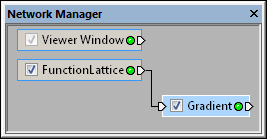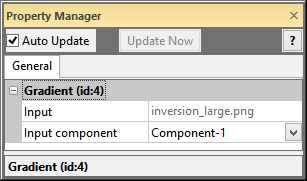
Select the Gradient module in the Network Manager
to display its properties in the Property Manager.

Use the Gradient module to create a gradient field
from a component of the input lattice.
The Network | Computational | Gradient command adds a Gradient module.
The Gradient module computes a gradient field from a single component of a two- or three-dimensional lattice. A gradient is a three-dimensional vector pointing in the direction of greatest slope. The output lattice contains three-component data at each lattice node. A centered difference algorithm is used to calculate the gradient. The output lattice geometry is identical to the input lattice geometry.
Lattice is the input type for the Gradient module.
The Gradient module creates a lattice. It may be connected to the Graphics Output Modules or the Computational Modules. An Info Module may also be connected to the output node.
The Gradient properties are described below.

Select the Gradient module in
the Network Manager
to display its properties in the Property
Manager.

Use the Gradient module to create
a gradient field
from a component of the input lattice.
The Input property shows the source to which the module is connected. This option cannot be changed in the Property Manager, but can be changed in the Network Manager by changing the module input.
The Input component shows the component from the input lattice used to calculate the gradient. To change the component, click the current selection and select the desired component from the list. The geometry of the output lattice mirrors the geometry of the input lattice.
For uniform and rectilinear input lattices, the components of the output lattice are:
dT/ dU, dT/ dV, dT/ dW if the input lattice has three dimensions,
dT/ dU, dT/ dV, 0 if the input lattice has two dimensions, and
dT/ dU, 0, 0 if the input lattice has one dimension.
The first derivatives are calculated using central differences, if possible, and forward or backward differences as necessary.
For curvilinear input lattices, the components of the output lattice are always dT/ dU, dT/ dV, dT/ dW .
Unlike the cases of uniform and rectilinear lattices, a one- or two-dimensional gradient lattice makes no sense with a curvilinear geometry. The components of the local gradient are computed by fitting a local linear model to the current node and its six cardinal neighbors: T(U, V, W) = aU + bV + cW + d. With this local linear model, the gradient vector is simply (a, b, c).
See Also